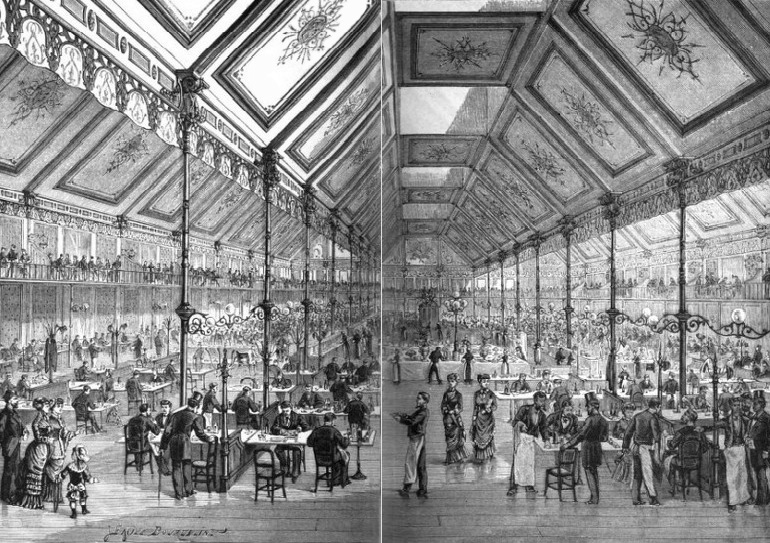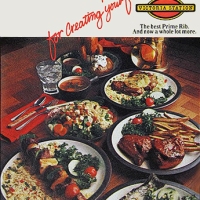Sometimes you need to leave your own country in order to get some perspective on it. Along with going back in time, that is what I’ve done. I’ve gone to France — though only through texts and pictures — to explore a restaurant chain begun in the 19th century known as Bouillon Duval.
I tend to think of the United States as the home of restaurant chains, and that they are quintessentially American. There is some truth to this, but it is also full of blind spots as the existence of the Duvals shows. They came before American chains, and showed that a highly rationalized, business-like approach to running restaurants is not solely American. [pictured, rue Poissonniere, 1882]
Looking at Bouillon Duval, which began as a soup restaurant, also dispels a bit of romanticism about French restaurants. As much as Duvals emphasized quality, they were eating places for the frugal masses, not temples of haute cuisine. In the beginning they were meant for poor workmen, but soon they became popular with the middle class. To put it in the language of the day, the “black coats drove out the blouses” who were embarrassed to be in the presence of the better dressed.
The Bouillons were the idea of Baptiste Adolphe Duval. He had a butcher shop in Paris and came from a family that ran a brasserie in the north of France. According to legend, around 1857 he opened a small soup restaurant near his shop using the unsalable meat scraps, and went on from there to become fabulously successful and wealthy. By 1867 he had eight Bouillons Duval in the city as well as at least one at that year’s world’s fair.
Of course it wasn’t quite that simple, and he might have failed if it hadn’t been for his wife’s assistance. According to the most thorough account of the chain’s development, the business was headed for failure as soon as it expanded beyond the small shop. With an enlarged menu and a lot of ideas, M. Duval had moved to a location in a former ballroom on the rue Montesquieu [shown at top of page in 1882, when it had reinstated male waiters]. There he installed a steam-heat system of cooking, along with elaborate piping that served every table with seltzer water. Both innovations were disastrous failures that cost a fortune to tear out. Add to this the lack of an accounting system that made it hard to calculate sales and permitted chiseling on the part of employees and the business was soon drowning in debt.
His wife Ernestine helped set up an accounting system and suggested replacing the questionable male servers with married women of irreproachable character who she dressed in uniforms resembling nuns’ habits [pictured, 1902]. The business began to show a profit and soon expansion was underway. Not surprisingly, when M. Duval died in 1870 shareholders chose Ernestine to take over the corporation and expand it further.
The Duval company had incorporated in 1868, by then consisting not only of eating places but also its own butcher shops, slaughter houses, bakery [pictured, 1882], large laundry, and caves that stored wine.
The company achieved heroic status in 1870 when it somehow managed to stay open during the “Siege of Paris” when German forces surrounding the city cut off food supplies. Their continuing in operation was significant not only for providing meals but also in boosting morale. In 1900 the French government awarded the Duvals’ son Alexandre, then manager, with the medal of the Legion of Honor. By then the company ran 32 restaurants.
The Duval system was based on keeping prices low while serving a large volume of customers quickly and efficiently. It was thoroughly a la carte right down to an extra charge for a tablecloth if wanted. During the Siege a London man recorded what he ordered at one of the 14 Duvals. He and his companion ordered bread for 1 cent, potato soup for 2 cents, as well as roast mutton, puréed potatoes, green beans in white sauce, and a pint of Mâcon wine. The total bill – with tablecloth – came to 18 cents. [Above, a menu that was to be filled out by the customer, ca. 1882; See The American Menu blog for several Duval menus.]
Needless to say, the fact that wine and other alcoholic beverages appeared on menus set the Bouillons Duval apart from most early chains that later developed in the U.S., such as Childs.

Numerous Americans as well as English citizens frequented the Bouillons when visiting Paris [above, diners at the 1878 Paris International Exposition; the objects with handles on the tables are menus], and expressed a wish to have something like them in their own countries. In addition to serving quality food and decent wine at low prices they were known to be spotlessly clean, quite unlike most of the cheap fixed-price cafes that working people had frequented before the Bouillons came along. The major criticism against them was that portions were small. Some critics said that if a hungry diner ordered all they wanted they would find that their bill was as expensive as in a finer restaurant. Other guests complained about the crowds and the “deafening din of knives and forks clinking against plates and dishes.”
Nonetheless the Bouillons Duval were invariably recommended in guide books for visitors to the international fairs held in Paris in 1867, 1878, 1889, and 1900. In 1878 the Duval restaurants were said to have served 5M meals that year. Pictured above is one of several Duval locations at the 1889 Exposition.
At some point a Bouillon Duval was opened in London, and in the 1880s there was one advertised in Los Angeles that offered “hot soup and schooner lager beer, five cents.” I couldn’t determine whether it was connected to the Paris restaurants or not.
The last mention of the Paris Bouillons Duval I found was in 1924, when the chain was still said to be all over the city.
© Jan Whitaker, 2021





















 It's great to hear from readers and I take time to answer queries. I can't always find what you are looking for, but I do appreciate getting thank yous no matter what the outcome.
It's great to hear from readers and I take time to answer queries. I can't always find what you are looking for, but I do appreciate getting thank yous no matter what the outcome.


